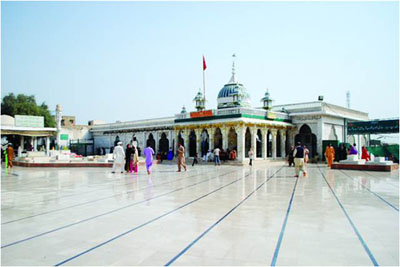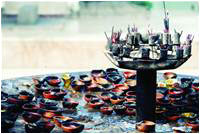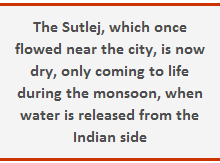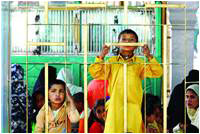The sweet-loving saint
It seems at first that Pakpattan has nothing to boast other than the shrine of this Sufi dervish. Once upon a time, however, it was an important market town that stood on the bank of the river Sutlej and formed a stop on the route from Multan to Delhi. The old name of the city is Ajoodhun. Ibn-e-Batuta, the famous Arab traveler, came here in the 14th century and records this name in his travelogue. Another name for the city was Ghar, which in Punjabi means important centre. Baba Fareed in his poetry refers to this name:
Ghar lutiya, devade gaya bojha
The city has been robbed, the lamps extinguished
The name Pakpattan was given to the city because of Baba Fareed. 'Pattan' is a place where the river crosses, and 'Pak' means pure. The Sutlej, which once flowed near the city, is now dry, only coming to life during the monsoon, when water is released from the Indian side. The old city is on a high mound, about 40-50 meters above the neighboring area. It must have been built over and over again on ancient ruins. It was originally inside a wall, with gateways. Now, however, the city has expanded far beyond its once-enclosing walls.
As one enters present-day Pakpattan, one has the feeling that the whole city is always celebrating Baba Fareed. Most of the shops, hotels, restaurants, and businesses are named after him. Their signs carry his picture, and show him emaciated after the rigorous fasting that he used to undertake to enhance his spiritual prowess. Edging closer to the shrine, the streets get denser and the shops closer. Several hundreds of devotees walk through the bazaar, while the cars, motorcycles and tongas struggle to pass through. On the way they are exhorted by the shopkeepers to buy flowers or chadars that bear verses from the Holy Quran. Prayer beads of various lengths hang from the roofs of these shops, along with threads of red and green to be worn on the wrist as a supplication. The shopkeepers wear green or white prayer caps. Most of them are clean-shaven, a few have moustaches and even fewer wear a neatly trimmed beard. The chadar is available in many colors such as red, orange and green, and always bears sacred verses within a golden boundary. It is bought to be presented to the grave of the saint. Women here are modestly covered, wearing shalwar kameez and their heads covered with dupattas. There is still a considerable number of women in the market, some accompanied by male relatives, others with just their children. Beggars stalk the devotees lingering around the bazaar for religious paraphernalia. They are mostly women, usually much darker in complexion than their counterparts at Lahori shrines. Their babies walk around with them naked, carrying their begging bowl for them. The beggar women usually roam in groups of 2-3 and get their food from the langar (community kitchen) of the shrine in plastic shopping bags. It is customary for beggars to angle for several bags at once, which they then take home for the rest of their family.
There are two separate entrances into the shrine, which is on a mound several meters above the ground. Two staircases lead to the top. The shrine sits on a rich historical mound, which was never explored by archaeologists and probably never will be. On this quiet mound, once outside the city, Baba Fareed spent the last days of his life, engrossed in meditation and prayer. Often he would have come across some relic of pottery or other things from the civilization that is assumed to have flourished here many thousands of years ago. Now the mound is completely covered with the site of the shrine. One entrance is for men while the other is for women. Families who have come together separate here and then meet inside after passing the rigorous security search: there are metal detectors and the frisking hands of policemen; for women the frisking is done by policewomen inside a curtained enclosure. No cameras are allowed inside the shrine. Nowadays there is always one police officer sitting on a chair and surveying the checking process with his gun laid in front of him in preparation for any untoward incident.
At the base of the second staircase that leads to the final floor is a counter where shoes are handed in. One needs to pay Rs 10 here and is given a token which is used for collecting one's shoes on the way back. No one can enter the shrine with their shoes on. (No money is taken at Sikh Gurdwaras or Hindu Temples at the shoe counter. Neither is any payment made at Muslim dargahs in India. But in Pakistan all major Sufi shrines extort a payment for taking care of the shoes, with sometimes the prices being exorbitantly high, especially at popular shrines. In contrast to this the Sikh devotees voluntary work at counters as part of their sewa (voluntary work) for religion.)
Midway on the stairs there is a space to perform the ritual ablution; many visitors purify their bodies here before entering the sacred space. There is another police personnel deployed here. The security of the shrine has been beefed up in recent years, as it has at many other shrines in Pakistan. On the 25th of October, 2010, there was a bomb blast at the entrance of this shrine that killed 6 people. This was after similar attacks had already occurred at Data Darbar in Lahore and Shah Ghazi's shrine in Karachi, two of the most important Sufi shrines in the country. Hard-line Muslims, who follow the Deobandi, Wahabi and Ahl-e-Hadith schools of thought, look down upon the shrine culture, which includes music, dance and other "un-Islamic" activities. Al-Qaeda and Taliban cadres often come from these aforementioned schools of thought. On the other hand, the Ahle-Sunnat and Barelvi sects give particular importance to Sufi saints and their shrines. With the rise in extremism after 9/11 the battle between the sects has come to the fore. Many shrines have been attacked in the recent past, which has played a major role in affecting the culture of Sufi shrines. Earlier these places acted as a refuge for the distressed and the oppressed. Now they have become forts, always manned by security officials who keep an eye on all the visitors.
The stairs lead into an open courtyard, where several hundred people are scattered all around and engaged in different activities. From the top one gets a panoramic view of the city below. On the left side is the huge mosque, a recent construction. There is a board at the main entrance of the mosque that says: "It is prohibited to sit idly at the mosque." The mosque is just one big prayer room. There are several fans inside, inviting the devotees to take a nap in the summer afternoons; but the administration at the shrine makes sure no one does that.
The administration of the shrine is the responsibility of the Auqaf Department. This government department was set up during the tenure of General Ayub Khan in the 1960s to look after Muslim shrines and historical mosques. They are also responsible for collecting revenues from here, and do the necessary maintenance work. Before the Auqaf Department was formed, the revenue collection and administration were the responsibility of the successors of the Sufi saints. It is argued that the government created this department to weaken the traditional power structures, which the military government of the time saw as a threat. The current Prime Minister of the country, Yousuf Raza Gillani, and the former Foreign Minister Shah Mehmood Qureishi are both direct descendents of two highly popular Sufi saints from Multan. The annual revenue from these shrines runs into several millions of rupees. According to the data provided by the department, it currently looks after 320 shrines in the country, which together provide an annual income of Rs 800 million.
This new-looking mosque, built by the Auqaf Department, was the site of an historical mosque said to be from the time of Baba Fareed. In the 1980s, during General Zia's rule, the old mosque was destroyed and this new one was constructed amidst a strong protest by several sections of society. The Indian government also requested the Government of Pakistan to refrain from demolishing the old mosque, but the Auqaf Department cited damage beyond repair as its reason and refused to heed to suggestions.
The Indian Government takes a keen interest in the shrine of Baba Fareed because of his association with the founder of the Sikh religion, Guru Nanak. Nanak traveled to Pakpattan about 300 years after the Sufi saint and collected his poetry from there. The spot where he did so is towards the Western side of the city and is now known as Tibba Baba Nanak. A Gurdwara was constructed here to commemorate the spot by Sikh devotees much later. By collecting Fareed's poetry, Nanak was able to preserve it. Guru Granth Sahib, the holy book of the Sikhs, is the primary source of Fareed's poetry now, the only written record of it we have. Because it was included by Nanak in the Granth Sahib, the Sikhs regard Fareed's poetry as Divine; the word of God said through his men. Baba Fareed wrote all his poetry in shrok. This is a form of poetry which only has 2 verses. Fareed is the founder of this form. He also happens to be the first proper poet of the Punjabi language. One of the regular demands of Indian Sikhs and Hindus has been to grant special visas to pilgrims on the occasion of his urs, like they are granted on the occasions of Baba Nanak's birthday and the celebration of Vaisakhi at Hassan Abdal.
There is an enclosed room next to the stairs. The room is locked, but the devotees can look into it through the window panel. Devotees cling to this panel. Some have tied a red string on it for the grant of a particular wish. There is nothing inside the room, but money put by the devotees through the window. (The officials of the Auqaf Department will come later in the day and take the money away.) Next to it, under the shade of the building, sitting on the cool marble floor, are the qawwals. Dressed in light brown shalwar kameez with white prayer caps on their heads, they sing songs of devotion to Baba Fareed while facing his shrine on the opposite side of the courtyard. Visitors have collected around them, leaving a space between them and the shrine. Their mouths are reddened by the consumption of paan. The main singer takes the lead with his harmonium, while there is one dholki-wala accompanying him. The rest, younger in age, repeat after the singer, clapping their hands in a distinctive qawwal style, in which the fingers are held wide and the clap is loud and firm, giving a regular beat. Qawwali is an essential feature of Muslim shrines; from Nizamuddin Auliya's in Delhi to Data Darbar's in Lahore to Bulleh Shah's in Kasur to Baba Fareed's in Pakpattan. This musical and poetical enactment of devotion and spirituality is said to send the devotee into an out-worldly trance that other methods of prayer cannot achieve. A man having slipped into that trance stands up and starts moving fanatically in front of the qawwals and in what may be described as an un-rhythmic dance. This state is called haal, which literally means condition; the condition of the devotee's trance. No one stops him. Encouraged, another man joins him. The police personnel who are roaming around the shrine and stopping people from photographing one another on the premises stop and look at the dancers. After a little while they move on, continuing with their patrolling.
Qawwali in the Sufi shrines was initiated by the Chishti branch of Sufi Islam, to which Baba Fareed belonged. The branch derives its name from the city of Chisht in present day Afghanistan, where it was first expounded by the its founder Abu Ishaq Shami. The Chishti order, as it is known, emphasizes love, peace and tolerance. Other famous Sufi saints following this order are Moinuddin Chishti (12th century) of Ajmer Sharif in India and Nizamuddin Auliya (13th century CE) of Delhi. Two important traditions that this order introduced were the serving of langar and the performance of qawwali.
Next to this chamber are ancient waan trees whose fruit Baba Fareed is said to have eaten. Waans can live up to several centuries. There are a few graves underneath. The great irony is that rich people have purchased the right to be buried next to the wealth-renouncing Sufi. The grave of Baba Fareed is inside a modest building, which is adjacent to the waan trees. There is a covered courtyard next to it from where women can see the grave as they are not allowed to enter. Other visitors can also rest here, escaping the tormenting heat of South Punjab during the summers. There is a long queue of devotees vying to enter and see the grave of Baba Fareed to pay their respect to him. There are 2 entrances to the shrine. One of them, called the Bahishti darwaza, is always locked, and is opened only during Fareed's urs on the 5th of Muharram. It literally means the Gateway to Heaven. It is believed that if one passes from under that door, one is assured a place in heaven. Millions of devotees push and shove during Fareed's urs to pass through this door. Inside the tomb, Baba Fareed is buried with his elder son.
Surrounding the modest tomb of the saint are the more elaborate tombs of his descendants. This is a later construction from the 13th century, when India was ruled by the Muslim Delhi Sultanate. Made out of red bricks and a white dome on the top, the architectural style of the construction is akin to the shrine of Baha-ud-din Zakariya and his descendant Shah Rukn-e-Alam, the patron saints of Multan. No women are permitted inside this shrine. However, despite its aura and splendor, more devotees choose to visit the simpler grave of Baba Fareed, which eight hundred years after his death continues to inspire their devotion
Fridsy Times: May 4, 2012








